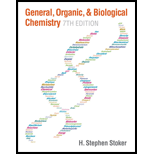
Concept explainers
(a)
Interpretation: The classification of the given
Concept introduction: The simplest hydrolyzed form that is obtained from the carbohydrates is known as monosaccharide. Monosaccharide is categorized into two types. The first type of monosaccharide is aldoses and the second type of monosaccharide is ketoses. Aldoses sugar possesses
Monosaccharides are also classified on the basis of the number of carbon atoms present in it. For example, the sugar that contains five carbon atoms is known as pentoses sugar and the sugar that contains six carbon atoms is known as hexoses sugar.
(b)
Interpretation: The classification of the given
Concept introduction: The simplest hydrolyzed form that is obtained from the carbohydrates is known as monosaccharide. Monosaccharide is categorized into two types. The first type of monosaccharide is aldoses and the second type of monosaccharide is ketoses. Aldoses sugar possesses aldehyde as a functional group and the ketoses sugar possesses ketone as a functional group.
Monosaccharides are also classified on the basis of the number of carbon atoms present in it. For example, the sugar that contains five carbon atoms is known as pentoses sugar and the sugar that contains six carbon atoms is known as hexoses sugar.
(c)
Interpretation: The classification of the given
Concept introduction: The simplest hydrolyzed form that is obtained from the carbohydrates is known as monosaccharide. Monosaccharide is categorized into two types. The first type of monosaccharide is aldoses and the second type of monosaccharide is ketoses. Aldoses sugar possesses aldehyde as a functional group and the ketoses sugar possesses ketone as a functional group.
Monosaccharides are also classified on the basis of the number of carbon atoms present in it. For example, the sugar that contains five carbon atoms is known as pentoses sugar and the sugar that contains six carbon atoms is known as hexoses sugar.
(d)
Interpretation: The classification of the given
Concept introduction: The simplest hydrolyzed form that is obtained from the carbohydrates is known as monosaccharide. Monosaccharide is categorized into two types. The first type of monosaccharide is aldoses and the second type of monosaccharide is ketoses. Aldoses sugar possesses aldehyde as a functional group and the ketoses sugar possesses ketone as a functional group.
Monosaccharides are also classified on the basis of the number of carbon atoms present in it. For example, the sugar that contains five carbon atoms is known as pentoses sugar and the sugar that contains six carbon atoms is known as hexoses sugar.
Trending nowThis is a popular solution!

Chapter 18 Solutions
GENERAL,ORGANIC,+BIO.CHEM.-MINDTAP
- Identify each of the following Haworth projection formulas as an a-D monosaccharide or a ß D-monosaccharide.arrow_forwardCan you please identify the name of each of the structures of sugar and identify as reducing or nonreducing sugar of a,b,c and d? The picture is posted. One of the structures may be not identified from the usual structures of disaccharides.arrow_forwardDoes trehalose (Problem 20.68) have an acetal grouping? A hemiacetal grouping? Do you expect trehalose to be a reducing or nonreducing sugar? Classify the linkage between the two monosaccharides.arrow_forward
- What is the structural difference between the monosaccharides glucose and galactose?arrow_forwardIdentify the name of each of the structures of sugar and identify as reducing or nonreducing sugar. One of the structures may be not identified from the usual structures of disaccharides. Kindly answer a, b, c, and d.You only identify the name of each structure of sugars and identify as reducing or nonreducing sugar. No explanation needed.arrow_forwardConsider the following statements: (1) The term sugar is a general designation for both monosaccharides and disaccharides. (2) The "penultimate carbon" in a monosaccharide is used to determine D- or L-configuration. (3) Sucrose is a reducing sugar and lactose is a nonreducing sugar. O Two of the three statements are true. All three statements are true. O Only one of the statements is true. None of the statements are true.arrow_forward
- ---is formed of a-glucose linked to B-fructose by (1,2 linkage). * Maltose O Lactose Sucrose Starcharrow_forwardRaffinose (see prev. question for structure) is not digestible by humans yet is found in foods we eat all the time like beans, cabbage, brussels sprouts etc. What 2 human digestible compounds can Raffinose be broken down into? Just as a side note, Raff is NOT digestible by us, but our helpful gut bacteria break it down for us into the 2 compounds that are the answer to this question. O a-D-glucose O B-D-fructose sucrose a-D-galactose Lactose maltosearrow_forwardwhat is the name of the monosaccharide A?arrow_forward
- D- and L- designations are used to distinguish between the two possible enantiomers of the monosaccharide, galactose. From the Fischer projection, determine the designation of this monosaccharide.arrow_forwardRaffinose, the most abundant trisaccharide found in nature, occurs in whole grains and numerous vegetables (e.g., asparagus, cabbage, and beans). Hydrolysis of raffinose yields galactose and sucrose. Provide the systematic name for this trisaccharide. Is raffinose a reducing or nonreducing sugar? Is raffinose capable of mutarotation?arrow_forwardLactose and maltose are reducing disaccharides, but sucrose is a nonreducing disaccharide. Explain.arrow_forward
 Human Anatomy & Physiology (11th Edition)BiologyISBN:9780134580999Author:Elaine N. Marieb, Katja N. HoehnPublisher:PEARSON
Human Anatomy & Physiology (11th Edition)BiologyISBN:9780134580999Author:Elaine N. Marieb, Katja N. HoehnPublisher:PEARSON Biology 2eBiologyISBN:9781947172517Author:Matthew Douglas, Jung Choi, Mary Ann ClarkPublisher:OpenStax
Biology 2eBiologyISBN:9781947172517Author:Matthew Douglas, Jung Choi, Mary Ann ClarkPublisher:OpenStax Anatomy & PhysiologyBiologyISBN:9781259398629Author:McKinley, Michael P., O'loughlin, Valerie Dean, Bidle, Theresa StouterPublisher:Mcgraw Hill Education,
Anatomy & PhysiologyBiologyISBN:9781259398629Author:McKinley, Michael P., O'loughlin, Valerie Dean, Bidle, Theresa StouterPublisher:Mcgraw Hill Education, Molecular Biology of the Cell (Sixth Edition)BiologyISBN:9780815344322Author:Bruce Alberts, Alexander D. Johnson, Julian Lewis, David Morgan, Martin Raff, Keith Roberts, Peter WalterPublisher:W. W. Norton & Company
Molecular Biology of the Cell (Sixth Edition)BiologyISBN:9780815344322Author:Bruce Alberts, Alexander D. Johnson, Julian Lewis, David Morgan, Martin Raff, Keith Roberts, Peter WalterPublisher:W. W. Norton & Company Laboratory Manual For Human Anatomy & PhysiologyBiologyISBN:9781260159363Author:Martin, Terry R., Prentice-craver, CynthiaPublisher:McGraw-Hill Publishing Co.
Laboratory Manual For Human Anatomy & PhysiologyBiologyISBN:9781260159363Author:Martin, Terry R., Prentice-craver, CynthiaPublisher:McGraw-Hill Publishing Co. Inquiry Into Life (16th Edition)BiologyISBN:9781260231700Author:Sylvia S. Mader, Michael WindelspechtPublisher:McGraw Hill Education
Inquiry Into Life (16th Edition)BiologyISBN:9781260231700Author:Sylvia S. Mader, Michael WindelspechtPublisher:McGraw Hill Education





